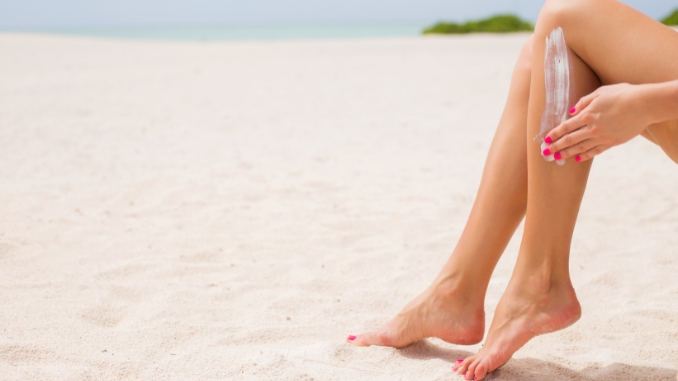In the sun’s warm embrace, we often find solace and joy, basking in its golden glow. However, amidst the blissful moments, we frequently underestimate the potential risks associated with prolonged sun exposure. Neglecting the importance of protective measures, such as sunblock application, has become a common oversight. Despite our awareness of the sun’s harmful effects, the tendency to procrastinate in reapplying sunblocks persists. This article aims to shed light on the consequences of such negligence, emphasizing the need for a mindful approach to sun protection for the sake of our skin’s health and longevity. So, continue reading to know more about sunscreen vs. sunblock.
Significance of Sun Protection Through Sunblock

Sunblock and sunscreen are essential elements in shielding our skin from the harmful effects of ultraviolet (UV) radiation. Whether labeled as sunblock or sunscreen, these protective measures play a pivotal role in preventing premature aging and sunburns and reducing the risk of skin cancer associated with prolonged UV exposure.
UV radiation poses serious threats, such as the breakdown of collagen, elastin, and DNA at a cellular level. To counteract these dangers, sunblocks and sunscreens act as protective barriers. They achieve this by absorbing, reflecting, or scattering UV rays, preventing them from penetrating the skin. The consistent use of these sun protection measures is also crucial for maintaining optimal skin health and mitigating the risk of sun damage.
Sunscreen vs sunblock, what’s the difference between the two? Both terminologies are often used interchangeably, but some argue that sunblock refers to physical blockers, like zinc oxide or titanium dioxide, creating a physical barrier on the skin. On the other hand, sunscreen may include chemical filters that absorb UV rays before they can damage the skin. However, the key lies in understanding that both aim to provide protection against harmful UV radiation.
Moreover, incorporating sun protection into daily skincare routines is imperative. Prolonged exposure to the sun’s ultraviolet rays can have consequences beyond aesthetic concerns, impacting the skin’s structural elements. By integrating sunblock or vs sunscreen into their regimen, individuals protect against the cumulative impact of UV exposure for aesthetic benefits and contribute to long-term dermatological well-being. Regular use of sunblock and sunscreen becomes a vital element in any skincare routine, serving as a shield against the sun’s potent rays and promoting both short-term and long-term skin health. Now that you already know what’s sunscreen vs. sunblock, let’s now dive in to UV rays.
Understanding UV Rays

The sun emits ultraviolet (UV) rays that can have detrimental effects on the skin, categorizing them into two main types: UVA and UVB. Prolonged exposure to UV radiation poses various issues, including premature aging, sunburns, and an increased risk of skin cancer. These rays penetrate the skin, causing cellular-level damage by breaking down collagen, elastin, and DNA.
Understanding the crucial distinction between UVA and UVB rays is essential for effective sun protection. UVA rays penetrate the skin more deeply and contribute primarily to premature aging through the breakdown of collagen and elastin. On the other hand, UVB rays mainly affect the outer layers of the skin and are responsible for sunburns. Despite their differences, both types of rays contribute to the overall risk of skin cancer.
Furthermore, to counteract the harmful effects of UV rays, sunblocks play a pivotal role by acting as a protective barrier. They employ various mechanisms, such as absorption, reflection, or scattering to prevent these rays from penetrating the skin. By comprehending how UVA and UVB rays impact the skin, individuals can make informed choices about sunblock vs sunscreen products, ensuring comprehensive protection against the sun’s detrimental effects.
Two Types of Sunblock
1. Physical (Mineral) Sunblocks
Physical sunblocks contain active mineral ingredients such as zinc oxide or titanium dioxide. These minerals act as a physical barrier on the skin, reflecting and scattering UV rays away from the skin’s surface. They are effective against both UVA and UVB rays and provide immediate protection upon application. Physical sunblocks are often recommended for individuals with sensitive skin, as they are less likely to cause irritation.
2. Chemical (Organic) Sunblocks
Chemical sunblocks contain organic compounds like avobenzone, octocrylene, or oxybenzone. These compounds work by absorbing UV radiation and converting it into heat, which is then released from the skin. Chemical sunblocks are typically transparent when applied, making them aesthetically appealing. They are effective against either UVA or UVB rays, and some formulations combine multiple chemical filters for broad-spectrum protection. It’s important to note that some individuals with sensitive skin may experience irritation with certain chemical sunblock ingredients.
The Key Components to Look for in a Sunblock

When choosing a sunblock, it’s important to look for key components that ensure effective sun protection. Here are the essential elements to consider:
1. Broad-Spectrum Protection
Ensure the sunblock offers broad-spectrum protection to shield against both UVA and UVB rays. This helps prevent issues such as premature aging, sunburns, and the risk of skin cancer.
2. SPF (Sun Protection Factor)
Check the SPF rating, which indicates the level of protection against UVB rays. Higher SPF values provide more extended protection. SPF 30 or higher is generally recommended for daily use.
3. Active Ingredients
Understand the active ingredients in the sunblock. Common ones include zinc oxide, titanium dioxide, avobenzone, and octocrylene. These ingredients contribute to the sunblock’s efficacy in blocking or absorbing UV rays.
4. Water Resistance

If you’ll be swimming or sweating, choose a sunblock labeled as water-resistant. Keep in mind that no sunblock is entirely waterproof, so reapplication after swimming or heavy sweating is crucial.
5. Skin Type Consideration
Consider your skin type and any specific skin sensitivities. Some individuals may prefer mineral sunblocks (zinc oxide or titanium dioxide) for sensitive skin, while others may opt for chemical sunblocks.
6. Non-Comedogenic
If you have acne-prone or sensitive skin, look for a sunblock labeled as non-comedogenic. This means it won’t clog pores, reducing the risk of breakouts.
7. Fragrance-Free or Hypoallergenic
Opt for a fragrance-free or hypoallergenic sunblock, especially if you have sensitive skin or allergies. Fragrances can sometimes cause irritation also.
8. Ease of Application
Consider the texture and ease of application. Sunblocks come in various forms, including lotions, creams, gels, and sprays. Choose one that suits your preference and makes the application convenient.
9. Expiration Date
Check the expiration date on the product to ensure its effectiveness. Expired sunblocks may not provide the intended level of protection.
10. Dermatologist Recommendations
If you have specific skin concerns or conditions, consult with a dermatologist for personalized recommendations. They can provide guidance based on your individual needs.
Elements to Avoid in Choosing a Sunblock

When choosing a sunblock, it’s essential to be aware of certain elements that may be less desirable or potentially irritating. Here are elements to avoid:
1. Oxybenzone
Oxybenzone is a chemical UV filter that has raised concerns about its impact on hormone disruption. Some people prefer sunblocks without oxybenzone, especially for children and individuals with sensitive skin.
2. Octinoxate
Octinoxate is another chemical UV filter that has been linked to hormone disruption. Some individuals choose sunblocks without octinoxate to minimize potential health risks.
3. Fragrances
Fragrances in sunblocks can cause skin irritation, especially for those with sensitive skin. Opt for fragrance-free or hypoallergenic options to reduce the risk of allergic reactions.
4. Parabens
Parabens are preservatives that are sometimes found in cosmetic products, including sunblocks. Some people choose sunblocks without parabens due to concerns about their potential hormone-disrupting effects.
5. Retinyl Palmitate
Retinyl palmitate is a form of vitamin A that also may be found in some sunblocks. There is debate about its safety, as some studies suggest that it may increase the risk of skin damage when exposed to sunlight. Consider sunblocks without retinyl palmitate if you have concerns.
6. Alcohol
High concentrations of alcohol in sunblocks may be drying and irritating to the skin. Look for sunblocks with lower alcohol content or ones that are labeled as alcohol-free, especially if you have dry or sensitive skin.
7. Spray Sunblocks
While convenient, spray sunblocks can pose inhalation risks, and it’s often challenging to apply them evenly. Additionally, it’s easy to miss spots when spraying, leading to inadequate sun protection. Consider alternatives like lotions or creams.
8. Non-Comedogenic Claims
Be cautious with sunblocks labeled as non-comedogenic, as individual reactions can vary. If you have acne-prone skin, consider patch-testing the product before widespread use.
Sun Safety Tips

A. Proper Application Techniques
- Apply Generously: Use a sufficient amount of sunblock to cover all exposed skin. This typically means about one ounce (enough to fill a shot glass) for most adults for each application.
- Even Application: Ensure an even application by spreading the sunblock thoroughly. Pay attention to commonly overlooked areas like the ears, neck, back of the hands, and then the tops of the feet.
- Early Application: Apply sunblock at least 15-30 minutes before sun exposure to allow it to bind with the skin properly.
- Lip Balm with SPF: Don’t forget to protect your lips by using a lip balm with SPF.
B. Reapplication Frequency
- Every Two Hours: Reapply sunblock every two hours, even on cloudy days. More frequent reapplication may be necessary if swimming or sweating heavily.
- After Swimming or Sweating: Reapply sunblock immediately after swimming or sweating to maintain continuous protection.
C. Additional Sun Protection Measures

- Clothing: Wear protective clothing, such as long-sleeved shirts, pants, and wide-brimmed hats, to shield your skin from direct sun exposure.
- Sunglasses: Protect your eyes by wearing sunglasses that block both UVA and UVB rays. Look for sunglasses labeled as providing 100% UV protection.
- Seek Shade: Limit direct sun exposure during peak hours, typically between 10 a.m. and 4 p.m.
- Use Umbrellas or Sunshades: When outdoors, especially at the beach or during outdoor activities, consider using umbrellas or sunshades for additional shade.
- Stay Hydrated: Drink plenty of water to stay hydrated, especially in hot weather. Proper hydration supports overall skin health.
- Check UV Index: Be aware of the UV index in your area. Higher UV index values indicate a greater risk of harm from unprotected sun exposure.
- Protective Clothing Technology: Explore clothing with UPF (Ultraviolet Protection Factor) for added sun protection. UPF clothing is designed to block UV rays effectively.
Conclusion: Sunscreen vs Sunblock
In conclusion, sunblock plays a crucial role in preserving skin health by protecting against the harmful effects of UV radiation, such as premature aging, sunburns, and an increased risk of skin cancer. Understanding UVA and UVB rays underscores the need for comprehensive sun protection, with sunblocks serving as a vital defense.
Making informed choices as consumers is also essential. Consider active ingredients, SPF levels, and personal preferences to tailor sunblock choices to your skin type and lifestyle. Avoiding elements like oxybenzone and fragrances enhances the personalized sun protection experience.
Emphasizing the long-term benefits of sun protection is key. Consistent use of sunblocks and adopting sun safety measures prevent sun damage, maintain youthful skin, and reduce the risk of skin disorders. By incorporating these habits into daily life, individuals shield their skin from immediate harm and also promote lasting dermatological well-being.
Prioritizing sun protection measures, with sunblock leading the way, empowers responsible outdoor enjoyment while safeguarding skin health. Educated choices and adopting these practices contribute to a holistic skincare approach, ensuring our skin’s enduring beauty and resilience.







